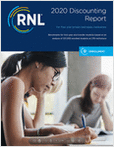 | After years of steady increases, overall discount rates finally appeared to be stabilizing last year. From 2010–2017, the average discount rate for RNL’s four-year private client institutions increased from 37.3 percent to 42.6 percent. However, from 2017–19, the discount rate has increased less than 1 percentage point, from 42.6 in 2017 to 43.3 percent in 2019. For our public client institutions, discounting fell from 16.7 percent to 14.4 percent in the past year and is the lowest rate since we began including public colleges and universities in this study. That stabilization is certainly a welcome sign for enrollment and financial aid professionals. However, at the same time, enrollment has stagnated for several years, and in fall 2019, fell across all sectors of higher education by 1.3 percent according to the latest government data.1 The flattening of overall enrollment growth resulting from demographic and socioeconomic changes has been underway for several years. With more competition for fewer students, enrollment managers will need to make sure they provide the aid that students need and expect in order to secure their enrollment. This report summarizes aggregate data from public and private institutions using RNL Advanced FinAid Solutions. It includes key metrics for enrollment, financial aid, and net revenue, including:
Request Free! |
